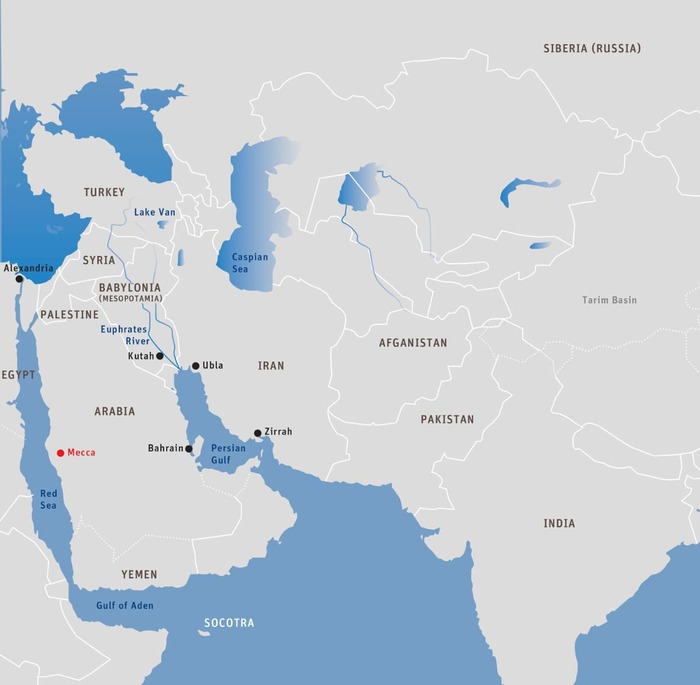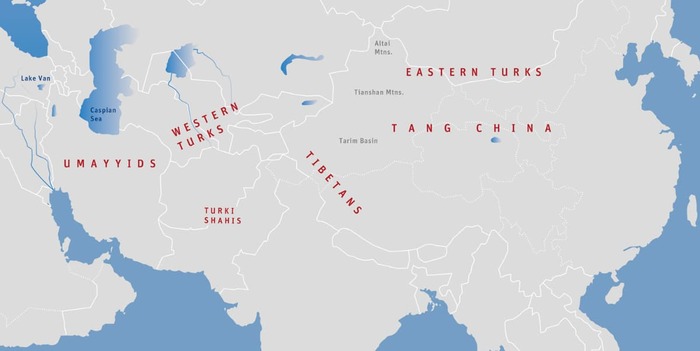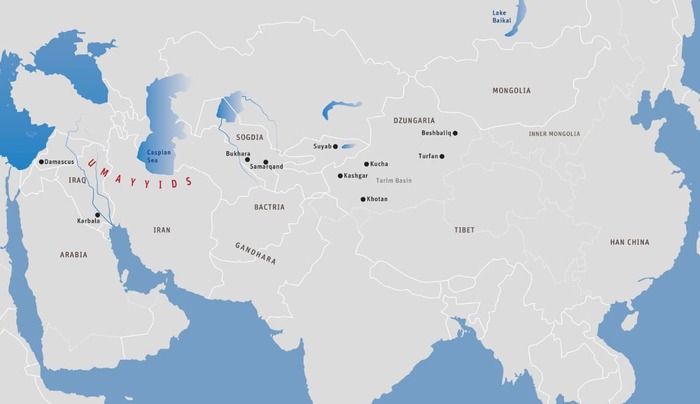The Pre-Islamic Presence of Buddhism in North Africa and West Asia
India and West Asia have a long history of land and sea trade between them. Commercial relations between India and Mesopotamia began as early as 3000 BCE and between India and Egypt, through the intermediary ports of Yemen, from 1000 BCE. The Baveru Jataka, a chapter from an early Buddhist collection of accounts of the previous lives of the Buddha, refers to maritime trade with Babylon (Sanskrit: Baveru).
In 255 BCE, the Indian Mauryan emperor, Ashoka (r. 273 – 232 BCE), sent Buddhist monks as ambassadors to establish relations with Antiochus II Theos of Syria and Western Asia, Ptolemy II Philadelphos of Egypt, Magas of Cyrene, Antigone Gonatas of Macedonia, and Alexander of Corinth. Eventually, communities of Indian traders, both Hindu and Buddhist, settled in some of the major sea and river ports of Asia Minor, the Arabian Peninsula and Egypt. Indians of other occupations soon followed. The Syrian writer, Zenob Glak, wrote of an Indian community, complete with its own religious temples, on the upper Euphrates River in modern-day Turkey to the west of Lake Van in the second century BCE, and the Greek ex-patriot, Dion Chrysostom (40 – 112 CE), wrote of a similar community in Alexandria. As evidenced by archeological remains, other Buddhist settlements were south of Baghdad on the lower Euphrates River at Kufah, on the eastern Iranian coast at Zir Rah and at the mouth of the Gulf of Aden on the island of Socotra.
With the decline of Babylonian and Egyptian civilizations in the middle of the first millennium CE and the simultaneous curtailing of Byzantine shipping in the Red Sea, much of the trade between India and the West came by sea to the Arabian Peninsula and then proceeded by land through Arab intermediaries. Mecca, the birthplace of the Prophet Muhammad (570 – 632 CE), became an important trade center where merchants met from the East and the West. More Indian communities established themselves in the Arabian cultural area. Among them, one of the most prominent were the Jats (Arab. Zut), many of whom settled in Bahrain and at Ubla, near modern-day Basrah at the head of the Persian Gulf. The Prophet’s wife, Aisha, was once treated by a Jat physician. Thus, Muhammad was undeniably familiar with Indian culture.

As further evidence, the mid-twentieth century scholar, Hamid Abdul Qadir, in his Buddha the Great: His Life and Philosophy (Arabic: Budha al-Akbar Hayatoh wa Falsaftoh), proposes that the Prophet Dhu’l Kifl (The Man from Kifl), mentioned twice in the Quran as patient and good, refers to Buddha, although most assert him to be Ezekiel. According to this theory, “Kifl” is the Arabic rendition of “Kapilavastu,” the Buddha’s birthplace. This scholar also suggests that the Quranic reference to the fig tree likewise refers to the Buddha who attained enlightenment at the foot of one.
The Tarikh-i-Tabari, a tenth century reconstruction of the early history of Islam written in Baghdad by al-Tabari (838 – 923), speaks of another group of Indians present in Arabia, the Ahmaras or “Red-Clad People” from Sindh. These were undoubtedly saffron-robed Buddhist monks. Three of them reportedly explained philosophical teachings to the Arabs during the first few years of the Islamic era. Thus, at least some Arab leaders were aware of Buddhism before they extended Islam beyond the Arabian Peninsula.
The Establishment of the Umayyad Caliphate
After the Prophet passed away, Abu Bakr (r. 632 – 634) and then Umar I (r. 634 – 644) were elected caliph, his worldly successor. During the reign of the latter, the Arabs conquered Syria, Palestine, Egypt, part of North Africa and began their assault on Iran. A six-man council then offered the caliphate to Ali, the Prophet’s cousin and son-in-law, but with conditions he could not accept. The caliphate then passed to Uthman (r. 644 – 656), who completed the overthrow of the Sassanids in Iran in 651 and established the Murjiah movement within Islam. He decreed that non-Arabs could become Muslims if outwardly they obeyed Sharia law and accepted the rule of the caliph. Only Allah, however, could judge their inner piety.
Uthman was eventually assassinated by the faction that supported Ali. Civil war ensued in which first Ali and then his eldest son, Hassan, were murdered after briefly holding the caliphate. Mu’a waiya, the Prophet’s brother-in-law and leader of the supporters of Uthman, finally triumphed, declaring himself the first caliph (r. 661 – 680) of the Umayyad line (661 – 750). He shifted the capital from Mecca to Damascus, while the rival claim to the caliphate fell upon Ali’s younger son, Husayn. The earliest contacts between the Muslim Arabs and Buddhists in Central Asia occurred shortly thereafter.

The Umayyad Attack on Bactria
In 663, the Arabs in Iran launched their first attack on Bactria. The invading forces captured from the Turki Shahis the area around Balkh, including Nava Vihara Monastery, causing the Turki Shahis to retreat southward to their stronghold in the Kabul Valley. Soon, the Arabs were able to extend their control northward and make their first inroads into Sogdia by taking Bukhara from the Western Turks.
The Arab military policy was to kill all who resisted, but to grant protected status to those who submitted peacefully and to exact tribute from them in either money or goods. They guaranteeed the latter arrangement through making a legal covenant (Arab. ‘ ahd) with any city that submitted by treaty. Strictly following Islamic law that once given, a covenant or contract is binding and cannot be retracted, the Arabs gained the trust of potential new subjects so that there was less resistance to their takeover.
Religious policy followed the military one. Those who accepted Arab rule by treaty were allowed to keep their religions by paying a poll tax. Those who resisted faced conversion to Islam or the sword. Many, however, voluntarily accepted Islam. Many wished to avoid the poll tax, while others, particularly merchants and artisans, saw additional economic advantages that would come from conversion.
Although some Buddhists in Bactria and even an abbot of Nava Vihara converted to Islam, most Buddhists in the region accepted protected status as loyal non-Muslim subjects within an Islamic state and paid the poll tax for non-Muslims exacted upon them. Nava Vihara Monastery remained open and functioning. The Han Chinese pilgrim Yijing (I-ching) visited Nava Vihara around the turn of the eighth century and reported it flourishing.
An Umayyad Iranian author, Omar ibn al-Azraq al-Kermani, wrote a detailed account of Nava Vihara at the beginning of the eighth century, preserved in the tenth-century work Book of Lands (Arabic: Kitab al-Buldan) by Ibn al-Faqih al-Hamadhani. He described it in terms readily understandable to Muslims by drawing the analogy with the Kaaba in Mecca. He explained that the main temple had a square stone in the center, draped with cloth, that people circumambulated. The square stone was undoubtedly referring to the platform upon which was erected a stupa reliquary monument, commonly found in the center of Bactrian and Tocharian temples. The cloth that draped it was in accordance with the Iranian custom for showing veneration, applied equally to Buddha statues as well as stupas, and circumambulation was the common Buddhist manner of worship. Nevertheless, al-Kermani’s description indicates an open and respectful attitude by the Umayyad Arabs in trying to understand the non-Muslim religions, such as Buddhism, that they encountered in their newly conquered territory
Previous Umayyad Experience with Non-Muslims in Iran
Prior to their invasion of Bactria, the Umayyads had conferred protected status and levied the poll tax on their Zoroastrian, Nestorian Christian, Jewish, and Buddhist subjects in Iran. Some local Arab officials, however, were less tolerant than others. Sometimes, protected subjects had to wear special clothes or badges identifying their status and were further humiliated by receiving a blow on the neck when they bowed in submission each time that they paid their poll tax. Although protected subjects had freedom of worship, some severe officials forbade them to build any new temples or churches. On the other hand, those who came for Friday prayers at the mosques sometimes received a monetary reward. In later times, if any member of a non-Muslim family converted to Islam, he would inherit all that family’s property. In addition, more aggressive officials frequently took foreigners, especially Turks, as slaves, but then offered them freedom if they converted.
The wish to avoid any such restrictions or humiliation and to receive financial or social benefits naturally drove many to denounce their religion and accept the new faith. Thus, many Zoroastrians in Iran eventually refused protected status and converted to Islam. It is unclear if a similar situation developed among the Buddhists in Bactria and Bukhara, but it is not unreasonable to assume that it did.
The process of converting to Islam was primarily an external affair at this time, in accordance with the Murjiah custom. One had simply to proclaim one’s acceptance of the primary articles of Islamic faith and carry out the basic religious duties of praying five times each day, paying the tax for relief of the Muslim poor, fasting during the month of Ramadan, and making pilgrimage to Mecca once in one’s life. Above all, one had to submit to Umayyad rule, for the main point demanded was a change of political, rather than spiritual allegiance. Those who broke the Sharia laws were tried in an Umayyad court and were punished, but still remained officially Muslim citizens with all civil privileges. Only Allah could decide who was sincere in their religious beliefs.
Such custom was tailored for winning subjects who would be faithful and obedient to Arab rule. It naturally attracted those who would convert simply as a political, social, or economic expedient, while internally maintaining belief in their own religions. The children and grandchildren of such converts, however, growing up in the external framework of Islam, became far more sincere than their parents and grandparents in accepting the new faith. In this way, the Islamic population of Central Asia began gradually to grow in a nonviolent manner.
The Slow Advance of the Umayyids into Southern Sogdia
The Umayyad takeover of the rest of Sogdia was not a simple matter. Three other powers were also vying to wrest control of the area from the Western Turks in order to gain control of the lucrative Silk Route trade that passed through it. These were the Tibetans from Kashgar, the Tang Chinese forces based in the rest of the Tarim Basin states, and eventually the Eastern Turks from Mongolia. The ensuing struggle became very complex. It is not necessary to give all the details. Let us simply summarize the important events during the second half of the seventh century and the first decade of the eighth so that we might appreciate the competition the Arabs faced.

First, in 670, the Tibetans took from Tang China the rest of the Tarim Basin city-states, starting with Khotan and several districts north of Kashgar. In face of a growing Tibetan military threat, the Tang forces gradually withdrew to Turfan from the rest of the Tarim Basin and the Tibetans filled the vacuum. The Tang army then skirted the Tibetans by crossing the Tianshan Mountains from Turfan to Beshbaliq and, proceeding westward, establishing a military presence in Suyab, northern West Turkistan, in 679. This was an exception, however, to the general trend of decline in Tang China. In 682, the Turks in Mongolia revolted against Tang rule and established the Second Eastern Turk Empire and, in 684, the Tang Dynasty itself was overthrown by a coup. It was not restored until 705, and not stabilized until 713.
Meanwhile, the Arab hold on Bactria started to weaken. In 680, at the beginning of the short reign of Caliph Yazid (r. 680 – 683), Ali’s younger son Husayn led an unsuccessful rebellion against the Umayyads in which he was killed at the Battle of Karbala in Iraq. This conflict diverted the focus of the Caliphate’s attention away from Central Asia. Subsequently, by the end of Yazid’s reign, the Umayyads lost control of most of the Bactrian city-states, but maintained their hold on Bukhara in Sogdia. In later years, remembrance of the martyrdom of Husayn helped crystallize the Shiite sect of Islam in counterpoint to the Sunni faction that developed from the Murjiah movement of the Umayyad line.
The Tibetan emperor of the time was preoccupied with an internal power struggle with a rival clan. Consequently, the Tibetans lost their strong grip on the Tarim Basin states in 692, although they continued to maintain a presence there, especially along the southern rim. The Han Chinese had a long tradition of trade relations with these states from their stronghold in Turfan, which classical Chinese histories refer to as “tribute missions.” Thus, although Tang China now became the dominant foreign power in much of the Tarim Basin beyond Turfan, this was on the basis of trade, not political or military control, particularly in the southern states.
In 703, the Tibetans formed an alliance with the Eastern Turks against the Tang forces at the eastern end of the Tarim Basin, but were unsuccessful in turning them out from Turfan. The Western Turks also set themselves against the Tang troops, but on the western front, and succeeded in ousting them from Suyab. The Western Turks then established the Turgish Turks, one of their subtribes, as rulers over northern West Turkistan. The Turgish homeland was the area around Suyab itself.
The Tibetans now allied themselves with the Turki Shahis of Gandhara and attempted, in 705, to drive the already weakened Umayyad forces from Bactria. For the time being, the Arabs were able to hold their ground. However, in 708, during the rule of Caliph al-Walid I (r. 705-715), the Turki Shahi prince, Nazaktar Khan, expelled the Umayyads from Bactria and established a fanatic Buddhist rule for several years. He even beheaded the former abbot of Nava Vihara who had converted to Islam.
Despite their loss of Bactria, the Umayyad forces continued to hold Bukhara in Sogdia. Advancing from the north, the Turgish took control of the rest of Sogdia and expanded beyond, taking Kashgar and Kucha in the western Tarim Basin. The Eastern Turks, another Tibetan ally, then entered the power struggle for Sogdia and, coming through Dzungaria, attacked the Turgish from the north, eventually capturing the Turgish homeland in Suyab. With the attention of the Turgish focused on their northern front, the Umayyad troops took advantage of the opportunity and, advancing from Bukhara, took Samarkand from the southernmost stretches of the Turgish domain.
Summary
The Umayyad Arabs’ initial hold on Bactria was not very strong and, consequently, their advance into Sogdia was very slow. They lacked the strength to launch attacks at will, but had to wait for moments of military distraction among the other major powers vying for Sogdia in order to make any progress. They were certainly not engaged in a holy war trying to spread Islam throughout Central Asia, but merely one of several power brokers struggling for political and territorial gain. The Arab General Qutaiba built the first mosque of Sogdia in Bukhara in 712. The fact that the next one was not built there until 771 indicates how slow the spread of Islam in fact was.